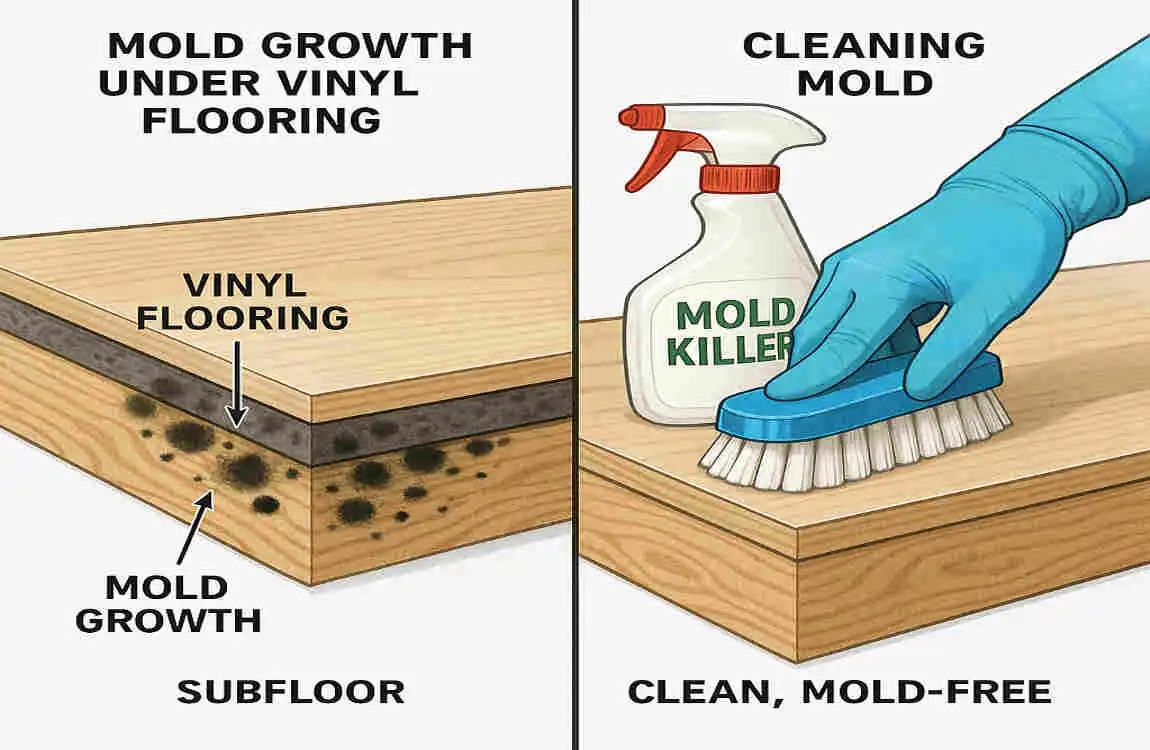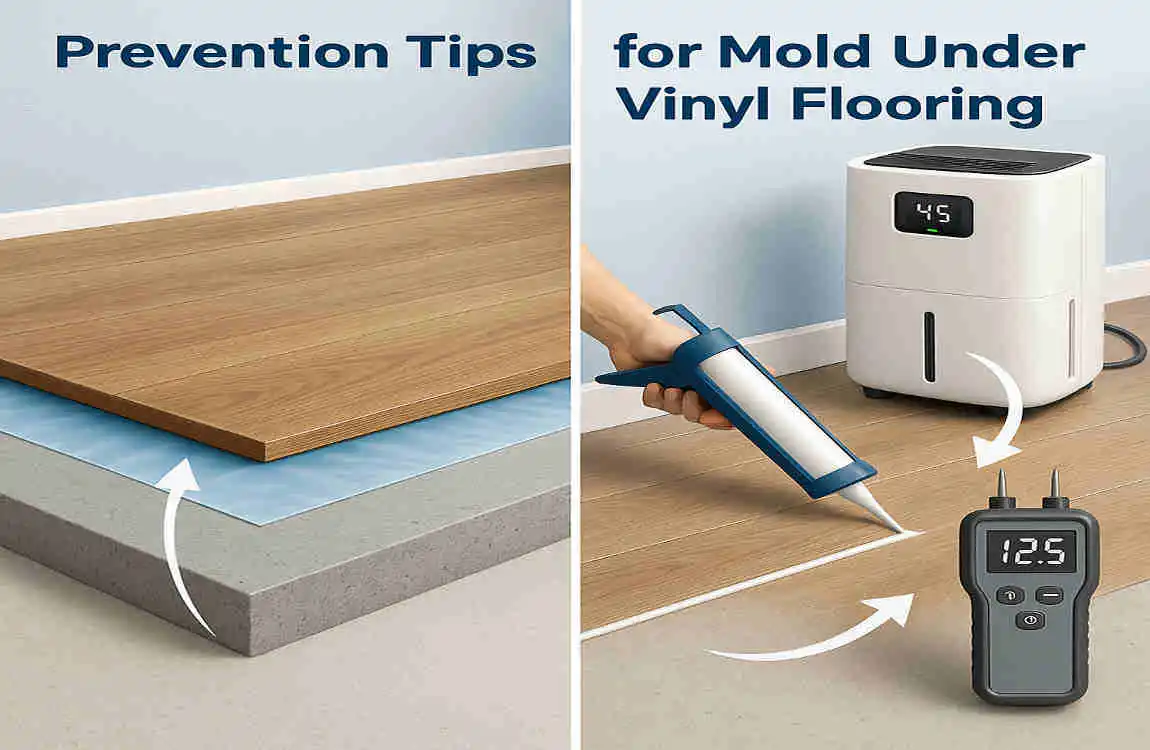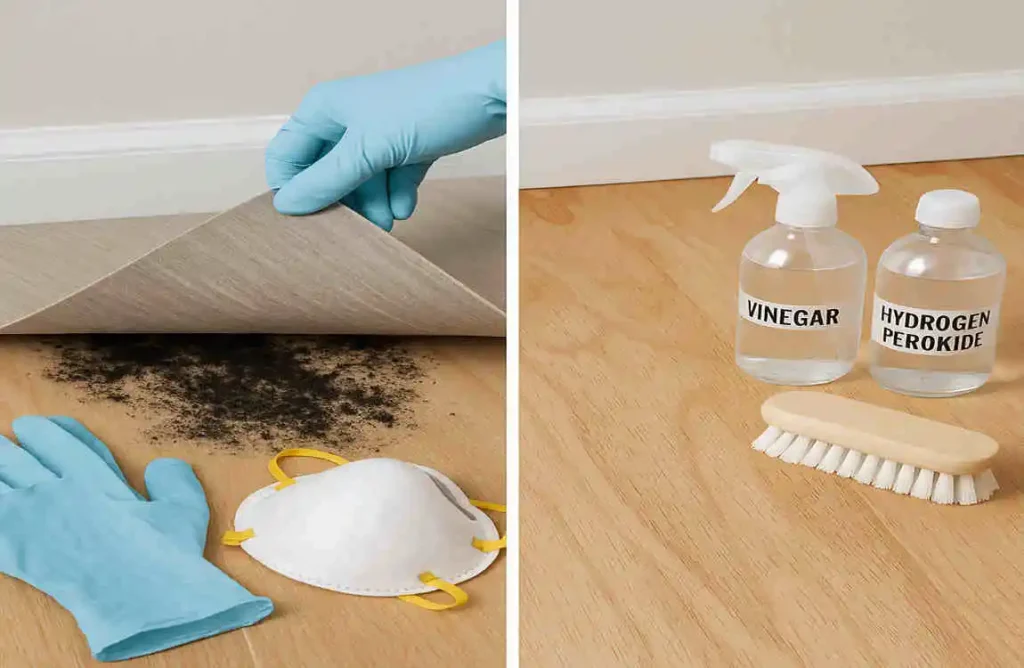Have you ever noticed a musty smell in your home or seen strange discoloration on your vinyl flooring? If so, you might be dealing with a mold problem lurking beneath your floors. Mold under vinyl flooring is not just an eyesore; it can pose serious health risks to you and your family.
Mold thrives in damp, dark places, making the space under vinyl flooring a perfect breeding ground. If left unchecked, mold can spread quickly, causing damage to your flooring and potentially leading to respiratory issues, allergies, and other health problems. That’s why it’s crucial to address mold growth promptly and effectively.
Understanding Mold Under Vinyl Flooring

What is Mold and Why Does it Grow Under Vinyl Flooring?
Mold is a type of fungus that thrives in moist environments. It reproduces by releasing tiny spores into the air, which can land on surfaces and grow into new mold colonies when conditions are right. Under vinyl flooring, mold can grow due to moisture from various sources, such as:
- Leaks from pipes, appliances, or the roof
- High humidity levels in the home
- Poor ventilation, especially in bathrooms and kitchens
- Spills or flooding that aren’t properly cleaned up
Vinyl flooring is particularly susceptible to mold growth because it creates a tight seal against the subfloor, trapping moisture underneath. This, combined with the lack of airflow, makes an ideal environment for mold to thrive.
Signs and Symptoms of Mold Under Vinyl Flooring
Detecting mold under vinyl flooring can be challenging, but there are a few telltale signs to look out for:
- A musty or earthy smell in the affected area
- Discoloration or staining on the vinyl flooring, especially along seams or edges
- Soft or spongy spots on the floor
- Visible mold growth along the edges of the flooring or in cracks
If you or your family members experience unexplained health symptoms such as persistent coughing, sneezing, or skin irritation, it may be a sign of mold exposure. It’s essential to investigate and address any potential mold issues promptly.
Health Risks of Mold Exposure in Homes
Common Health Issues Caused by Mold Exposure
Mold exposure can lead to a range of health problems, especially for those with pre-existing conditions or weakened immune systems. Some common health issues associated with mold exposure include:
- Allergic reactions, such as sneezing, a runny nose, and itchy eyes
- Respiratory problems, including asthma attacks and difficulty breathing
- Skin irritation, rashes, and hives
- Headaches and fatigue
Vulnerable Groups and Long-Term Impact
Certain groups are more susceptible to the health effects of mold exposure, including:
- Children, whose immune systems are still developing
- Elderly individuals, who may have weakened immune systems
- People with pre-existing respiratory conditions, such as asthma or allergies
- Those with compromised immune systems due to illness or medication
Ignoring mold under vinyl flooring can have long-term consequences for your health and your home. Mold can continue to spread and cause further damage to your flooring and subfloor, leading to costly repairs. Moreover, prolonged mold exposure can exacerbate health issues and potentially lead to chronic conditions.
Preparing for Mold Removal
Safety Precautions and Protective Gear
Before you begin the mold removal process, it’s crucial to take safety precautions to protect yourself and prevent the spread of mold spores. Here’s what you’ll need:
- Protective gear, including gloves, goggles, and a mask
- Plastic sheeting to cover furniture and belongings in the affected area
- A fan or air purifier to improve ventilation
Tools and Cleaning Supplies
To effectively remove mold under vinyl flooring, you’ll need the following tools and cleaning supplies:
- A utility knife or flooring removal tool
- A scraper or putty knife
- A stiff-bristled brush
- White vinegar or Hydrogen’s peroxide
- A spray bottle
- Microfiber cloths or sponges
- A dehumidifier or fans for drying the area
When to Call Professional Mold Remediation
While DIY mold removal can be effective for small areas, it’s essential to know when to call in the professionals. If you encounter any of the following situations, it’s best to seek professional help:
- Mold growth covers an area larger than 10 square feet
- You or your family members experience severe health symptoms related to mold exposure
- The mold is caused by a significant water leak or flooding
- You’re unsure about the type of mold or how to safely remove it
Professional mold remediation experts have the knowledge, experience, and equipment to safely and effectively remove mold from your home.
Assessing the Extent of Mold Growth
Before you begin the mold removal process, assess the extent of the growth. Look for visible signs of mold along the edges of the vinyl flooring, in cracks, or on the subfloor. You can also use a moisture meter to detect hidden moisture that may be contributing to mold growth.
By understanding the scope of the problem, you can better plan your mold removal strategy and ensure that you address all affected areas.
Step-by-Step Guide on How to Clean Mold Under Vinyl Flooring
Remove Vinyl Flooring Safely
The first step in removing mold under vinyl flooring is to carefully remove the affected flooring. Use a utility knife or flooring removal tool to cut the vinyl into manageable sections, taking care not to damage the subfloor beneath.
As you remove the flooring, be sure to wear protective gear and work in a well-ventilated area to minimize your exposure to mold spores. Place the removed flooring in plastic bags and seal them tightly to prevent mold from spreading.
Inspect and Identify Mold Spots
Once the vinyl flooring is removed, carefully inspect the subfloor for signs of mold growth. Look for discolored patches, fuzzy growth, or a musty smell. You may need to use a flashlight to thoroughly examine the area.
If you find mold on the subfloor, take note of its location and extent. This will help you determine the best course of action for removal and prevention.
Clean Mold on the Subfloor
To effectively remove mold from the subfloor, you’ll need to use an appropriate cleaning agent. Some effective options include:
- White vinegar: Mix equal parts water and white vinegar in a spray bottle. Spray the solution onto the moldy areas, let it sit for an hour, then scrub with a stiff-bristle brush.
- Hydrogen’s peroxide: Pour 3% Hydrogen’ peroxide directly onto the moldy areas and let it sit for 10 minutes before scrubbing. Be sure to test a small area first, as Hydrogen peroxide can discolor some surfaces.
- Commercial mold removers: Follow the manufacturer’s instructions for use, taking care to wear protective gear and ventilate the area well.
After applying the cleaning solution, use a scraper or putty knife to gently remove the mold from the subfloor. Be sure to dispose of any moldy debris in sealed plastic bags.
Disinfect and Dry the Area
Once you’ve removed the mold from the subfloor, disinfect the area to prevent regrowth. Use a solution of 1 part bleach to 10 parts water, or a commercial disinfectant, to thoroughly clean the subfloor.
After disinfecting, use fans, dehumidifiers, or natural ventilation to thoroughly dry the area. Mold thrives in moist environments, so ensuring the subfloor is completely dry is crucial for preventing future growth.
Address Underlying Causes of Moisture
To prevent mold from returning under your vinyl flooring, it’s essential to address any underlying causes of moisture. This may include:
- Fixing leaks in pipes, appliances, or the roof
- Improving ventilation in areas prone to moisture, such as bathrooms and kitchens
- Using a dehumidifier to maintain optimal humidity levels in your home
- Ensuring proper grading around your home’s foundation to prevent water from pooling near the building
By addressing these issues, you can create an environment that is less conducive to mold growth.
Reinstall Vinyl Flooring or Decide When Replacement is Needed
Once the subfloor is clean, dry, and free of mold, you can decide whether to reinstall the vinyl flooring or replace it entirely. If the vinyl is still in good condition and the mold was confined to the subfloor, you may be able to reinstall it.
However, if the vinyl is damaged or discolored, or if mold has penetrated the flooring, it’s best to replace it with new, mold-resistant vinyl flooring. When selecting new flooring, look for products with built-in mold resistance and consider using a mold-resistant underlayment for added protection.
Essential Tips and Common Mistakes to Avoid
- Always wear protective gear when removing and cleaning mold to minimize your exposure to spores.
- Work in small sections to ensure thorough cleaning and prevent mold spread.
- Never mix cleaning agents, as this can create harmful fumes.
- Avoid using bleach on porous surfaces, as it can discolor the material and may not effectively kill mold.
- Don’t attempt to remove mold if you have respiratory issues or a weakened immune system; seek professional help instead.
By following these tips and avoiding common mistakes, you can effectively remove mold under your vinyl flooring and create a healthier home environment.
Prevention Tips: How to Avoid Mold Under Vinyl Flooring in the future

Best Practices for Moisture Control
To prevent mold from growing under your vinyl flooring in the future, follow these best practices for moisture control:
- Use a dehumidifier to maintain optimal humidity levels (between 30-50%) in your home.
- Ensure proper ventilation in areas prone to moisture, such as bathrooms and kitchens.
- Fix any leaks or water damage promptly to prevent moisture from seeping under the flooring.
- Use area rugs or mats in high-traffic areas to absorb moisture and prevent it from reaching the flooring.
Regular Maintenance and Inspection Routines
Regular maintenance and inspections can help you catch mold growth early and prevent it from spreading. Consider the following routines:
- Inspect your vinyl flooring regularly for signs of mold, such as discoloration, soft spots, or a musty smell.
- Clean up spills and leaks immediately to prevent moisture from seeping under the flooring.
- Thoroughly clean your vinyl flooring at least once a year with a mild detergent and warm water.
Use of Mold-Resistant Vinyl Flooring Options and Underlays
When installing new vinyl flooring, consider using mold-resistant options and underlays for added protection. Look for products with built-in mold resistance, such as those treated with antimicrobial agents.
Mold-resistant underlays can provide an extra layer of protection between the vinyl flooring and the subfloor. These underlays are designed to prevent moisture from penetrating the flooring and creating an environment conducive to mold growth.
Improving Home Ventilation and Humidity Control
Proper ventilation and humidity control are essential for preventing mold growth in your home. Consider the following tips:
- Use exhaust fans in bathrooms and kitchens to remove moisture-laden air.
- Open windows and doors regularly to improve air circulation.
- Use a whole-house ventilation system to maintain a consistent flow of fresh air.
- Keep your home’s HVAC system clean and well-maintained to prevent moisture and mold buildup.
By implementing these prevention tips, you can create a home environment that is less conducive to mold growth and keep your vinyl flooring mold-free for years to come.
